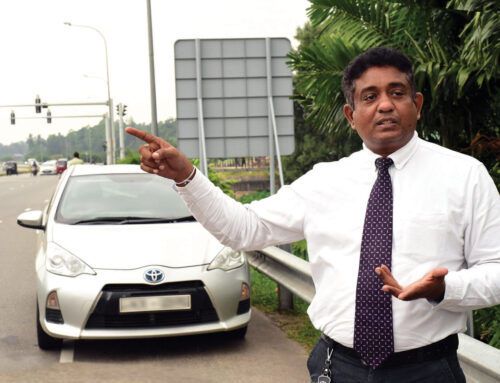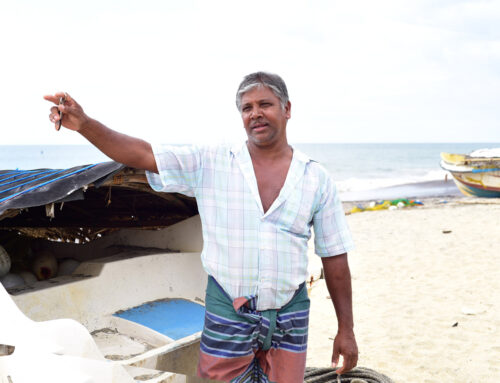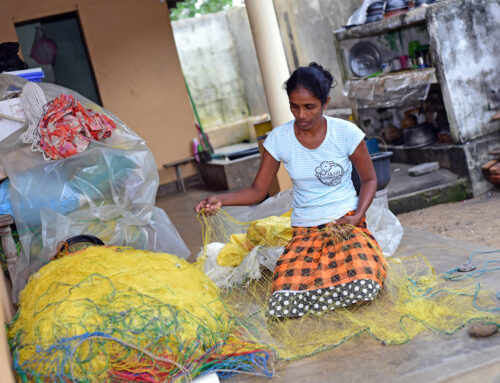“I believe the new Silk Road has more opportunities, including tourism, for both China and Sri Lanka to make better relationships by building Sri Lanka’s economic potential without destroying the historical relationships among the two nations for immediate trade benefits.
Ancient Silk Road Open for New Opportunities
Hemantha Withanage, Executive Director for Centre for Environmental Justice
Photographer: Chanaka Nalin
The history of dialogue and exchange between Sri Lanka and China goes back to about the 2nd Century B.C., connected by the ancient Silk Road. Later, in the 15th Century, Zheng He, the famous explorer and diplomat from Ming Dynasty, visited Sri Lanka six times. On his third visit, in 1411, Zheng He installed a stone tablet, in the southern port city of Galle, detailing in three languages: Chinese, Tamil and Persian, his previous trip to Sri Lanka and a mutual call and wish for a peaceful world. The trilingual tablet, called the Galle Inscription, is, today, preserved in the Colombo National Museum.
Sri Lanka and the People’s Republic of China first established bilateral trade relations in 1952 by signing the landmark Rubber-Rice Pact. In doing so, Sri Lanka became one of the first non-communist countries to establish trade relations with China. Since then, China has become one of Sri Lanka’s main trading partners and investors.[1] Today, the trade and exchange between China and Sri Lanka are taking place in the name of the Belt and Road Initiative (BRI). There are dozens of BRI projects, mainly funded and executed by Chinese companies, in Sri Lanka, and they cover a very wide range of sectors, such as power and energy, roads and transportation, telecommunications, airport and aviation, port, irrigation and water management.
China has invested an estimated $11 billion in Sri Lanka, around $8 billion in the form of loans related to the “Belt and Road Initiative”.[2]The total investment will easily exceed hundreds of billions once these projects all get completed. The Colombo International Financial City, also known as the Colombo Port City, a mega-financial hub, to be built on top of 269 hectares of land reclaimed in the bay off Colombo, and will have costed about 15 billion US dollars upon completion in 2041. Chinese loans comprise about 10 per cent of Sri Lanka’s total foreign debt.[3] Despite the huge amount of money flowing into the country and boosting the local economy, Sri Lankan people are not all happy with some of the BRI projects.
The Colombo Port City, for example, has not carried out a valid Environmental Impact Assessment (EIA), although the construction had already started in 2014. The dredging of approximately 65 million cubic meters of sea sand is causing irreversible damage not only to the coast and beach, but also to important coral reefs and fishing grounds, upon which over 15,000 local fishermen’s livelihood depends. Construction of Southern port in Hambanthota was another controversial deal.
Some other projects are quite welcomed. Based on Sri Lanka’s Department of External Resources (ERD) 2011 Performance Report, EXIM Bank of China committed a credit facility of US $259.78 million, in total, to Sri Lanka to finance several road projects. With this assistance, rehabilitation, and improvement have taken place for 67 km of Navakkuli- Karativu Mannar road, 113 km of Puttalam- Marichchukkaddi -Mannar road, 15 km of highway section from Pinnaduwa to Kodagoda , 15 km of highway section from Kodagoda to Godagama, and balance work in Galle Port Access Road.
The 15 km of Colombo-Matara highway section from Pinnaduwa to Kodagoda and the 15 km of highway section from Kodagoda to Godagama, as well as the balance work in Galle Port Access Road, was constructed by China National Technical Import & Export Corporation, which linked to a bigger project called Southern Transport Development Project (STDP).
These projects are less controversial since they don’t create much negative social and environmental impact. In fact, they provided more benefits to the local communities by expanding livelihood opportunities while increasing mobility.
Sri Lanka, as a developing nation, lacks capital for new investments. This is a major challenge. Its location is highly strategic, and many powerful nations will continue to keep their eyes on the country. In the meantime, Sri Lankans are moving from agriculture-based livelihoods to small enterprises and skill-based foreign income generation. The current president, Gotabhaya Rajapaksha, says that Sri Lanka doesn’t need loans but needs investments under his long-term vision for the country.
Now, Sri Lanka has adequate infrastructure, and it doesn’t need much infrastructure investments in the future. However, China, as a fast-growing economy with new technology, has the capacity to open up new non-polluting ventures in Sri Lanka, which will eventually lead to the growing of the national economy to improve the local livelihood. Sri Lanka can also benefit from China’s technology to generate renewable energy, rather than investing in high-polluting coal power plants, as is proposed to be done in Norochcholai.
China-Sri Lanka trade, cultural, religious, and social relationships, started a few centuries ago, can be improved and continued by building people-to-people relationship instead of using Sri Lanka as a strategic location to win the new trade wars between the north and south. I believe the new Silk Road has more opportunities, including tourism, for both China and Sri Lanka to make better relationships by building Sri Lanka’s economic potential without destroying the historical relationships among the two nations for immediate trade benefits.
The Centre for Environmental Justice (CEJ) is a non-profit, non-governmental organization that aims to protect the equal environmental rights of the people & environment and promote ecological sustainability by supporting ecologically sound community activities. CEJ works to protect and conserve Sri Lanka’s natural resources and preserve ancient wisdom that enabled previous generations to live in harmony with nature. The organization also works to establish better environmental governance for a sustainable future, environmental justice, and equity.
[1] https://carnegietsinghua.org/2019/07/23/why-unsustainable-chinese-infrastructure-deals-are-two-way-street-pub-79548
[2] https://www.reuters.com/article/us-sri-lanka-politics-china/a-hospital-and-clean-water-china-on-the-charm-offensive-in-sri-lanka-idUSKBN1XU01T
[3] https://www.eastasiaforum.org/2019/02/28/sri-lankas-debt-problem-isnt-made-in-china/




